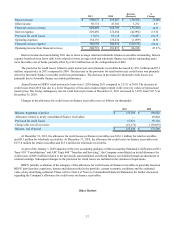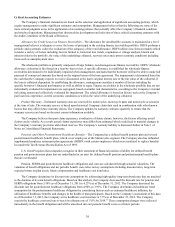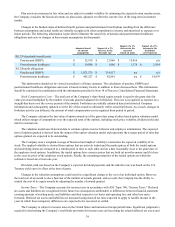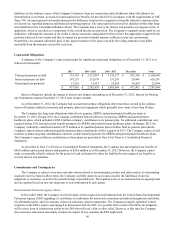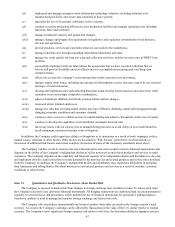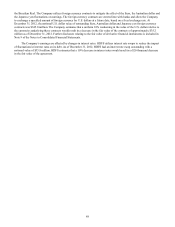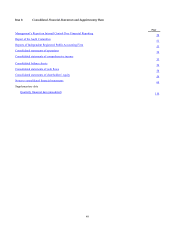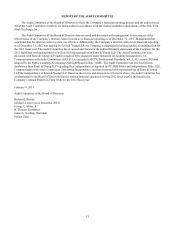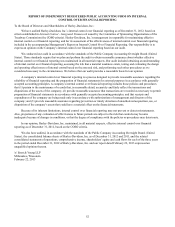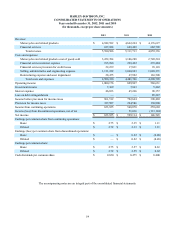Harley Davidson 2012 Annual Report Download - page 47
Download and view the complete annual report
Please find page 47 of the 2012 Harley Davidson annual report below. You can navigate through the pages in the report by either clicking on the pages listed below, or by using the keyword search tool below to find specific information within the annual report.47
(iv) implement and manage enterprise-wide information technology solutions, including solutions at its
manufacturing facilities, and secure data contained in those systems,
(v) anticipate the level of consumer confidence in the economy,
(vi) continue to realize production efficiencies at its production facilities and manage operating costs including
materials, labor and overhead,
(vii) manage production capacity and production changes,
(viii) manage changes and prepare for requirements in legislative and regulatory environments for its products,
services and operations,
(ix) provide products, services and experiences that are successful in the marketplace,
(x) manage risks that arise through expanding international operations and sales,
(xi) manage the credit quality, the loan servicing and collection activities, and the recovery rates of HDFS’ loan
portfolio,
(xii) successfully implement with our labor unions the agreements that we have executed with them that we
believe will provide flexibility and cost-effectiveness to accomplish restructuring goals and long-term
competitiveness,
(xiii) effectively execute the Company’s restructuring plans within expected costs and timing,
(xiv) manage supply chain issues, including any unexpected interruptions or price increases caused by raw material
shortages or natural disasters,
(xv) develop and implement sales and marketing plans that retain existing retail customers and attract new retail
customers in an increasingly competitive marketplace,,
(xvi) adjust to healthcare inflation and reform, pension reform and tax changes,
(xvii) retain and attract talented employees,
(xviii) manage the risks that our independent dealers may have difficulty obtaining capital and managing through
changing economic conditions and consumer demand,
(xix) continue to have access to reliable sources of capital funding and adjust to fluctuations in the cost of capital,
(xx) continue to develop the capabilities of its distributor and dealer network, and
(xxi) detect any issues with our motorcycles or manufacturing processes to avoid delays in new model launches,
recall campaigns, increased warranty costs or litigation.
In addition, the Company could experience delays or disruptions in its operations as a result of work stoppages, strikes,
natural causes, terrorism or other factors. Other factors are described in “Risk Factors” under Item 1A which includes a
discussion of additional risk factors and a more complete discussion of some of the cautionary statements noted above.
The Company’s ability to sell its motorcycles and related products and services and to meet its financial expectations also
depends on the ability of the Company’s independent dealers to sell its motorcycles and related products and services to retail
customers. The Company depends on the capability and financial capacity of its independent dealers and distributors to develop
and implement effective retail sales plans to create demand for the motorcycles and related products and services they purchase
from the Company. In addition, the Company’s independent dealers and distributors may experience difficulties in operating
their businesses and selling Harley-Davidson motorcycles and related products and services as a result of weather, economic
conditions or other factors.
Item 7A. Quantitative and Qualitative Disclosures About Market Risk
The Company is exposed to market risk from changes in foreign exchange rates and interest rates. To reduce such risks,
the Company selectively uses derivative financial instruments. All hedging transactions are authorized and executed pursuant to
regularly reviewed policies and procedures, which prohibit the use of financial instruments for speculative trading purposes.
Sensitivity analysis is used to manage and monitor foreign exchange and interest rate risk.
The Company sells its products internationally and in most markets those sales are made in the foreign country’s local
currency. As a result, the Company’s earnings can be affected by fluctuations in the value of the U.S. dollar relative to foreign
currency. The Company’s most significant foreign currency risk relates to the Euro, the Australian dollar,the Japanese yen and


